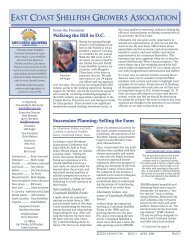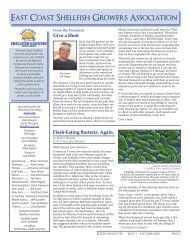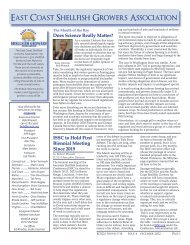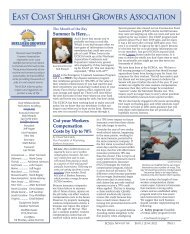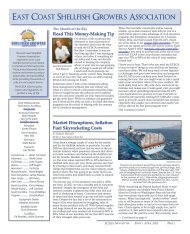ECSGA October 2022 Newsletter
This issue contains articles on social license for aquaculture, cultural benefits and social impacts of shellfish aquaculture, how best management practices differ from laws and regulations, mortality rates in floating gear vs. bottom gear, the story of how the Oceanfarmr (formerly known as SmartOysters) app came to be, and the difference between gross sales and net profit,
This issue contains articles on social license for aquaculture, cultural benefits and social impacts of shellfish aquaculture, how best management practices differ from laws and regulations, mortality rates in floating gear vs. bottom gear, the story of how the Oceanfarmr (formerly known as SmartOysters) app came to be, and the difference between gross sales and net profit,
You also want an ePaper? Increase the reach of your titles
YUMPU automatically turns print PDFs into web optimized ePapers that Google loves.
Why Best Practices? How<br />
Do They Differ From<br />
Laws and Regulations?<br />
by Robert Rheault,<br />
<strong>ECSGA</strong> Executive Director<br />
A “best practice” (often called a best management<br />
practice or BMP) is broadly defined<br />
as a technique or methodology that, through<br />
experience and testing, reliably leads to a<br />
desired result. Best practices differ from laws<br />
and regulations in many ways, and each has<br />
its pros and cons. Regulators often find that<br />
laws and regulations can be too inflexible,<br />
while best practices can offer a better way to<br />
get the regulated community to do the right<br />
thing. Best practices are typically voluntary,<br />
and while it might seem counter-intuitive,<br />
they are often more effective at obtaining<br />
compliance than laws and regulations.<br />
Best practices are quite different from laws,<br />
regulations and guidance. Laws are passed<br />
by the legislature and define the goals and<br />
objectives of government, usually providing<br />
justification and policy directives, and often<br />
dictating a range of appropriate penalties.<br />
Regulations are drafted by agencies to dictate<br />
precisely how to enforce the broader goals of<br />
the laws, and are typically drafted through a<br />
rule-making process that solicits public comment.<br />
And lastly, guidance is often offered<br />
by the agencies to help the regulated community<br />
understand the regulations and offer<br />
advice on compliance. Guidance does not require<br />
rulemaking and is typically not legally<br />
binding and does not have the “force of law”<br />
behind it. Laws and regulations<br />
usually cover requirements that<br />
ensure public safety and protection<br />
of natural resources and<br />
private property. They rely on<br />
enforcement officers and penalties<br />
ranging from fines to permit<br />
suspension to incarceration.<br />
Industry best practices are usually<br />
formed through a consensus-driven<br />
process by industry<br />
members who recognize that<br />
regulations and enforcement<br />
don’t adequately cover all of the<br />
things that growers should and<br />
could be doing. Best practices are<br />
enforced by peer pressure and expectations<br />
that industry members<br />
comply with certain “norms” for<br />
the benefit of the industry as a<br />
whole. Occasionally, best practices<br />
will be adopted as regulations.<br />
(Florida has adopted BMPs as<br />
regulations, but in my mind they<br />
are no longer best practices—they<br />
are now regulations.)<br />
Aquaculture is broadly regulated<br />
by a variety of agencies charged<br />
with enforcing dozens of applicable<br />
laws. Often a law will<br />
mandate that an agency seek<br />
opinions or approval from other<br />
agencies before it can permit an activity. For<br />
instance, the Army Corps of Engineers has<br />
the authority to regulate structures placed in<br />
the navigable waters of the U.S. It examines<br />
aquaculture applications based on issues<br />
related to navigation, and seeks comment<br />
from NOAA’s Protected Resources Division<br />
and the Department of Interior’s Fish and<br />
Wildlife Service related to compliance with<br />
the Marine Mammal Act, Migratory Species<br />
Act, Magnuson Stevens Act, Endangered<br />
Species Act, the EPA’s Clean Water Act, and<br />
many others.<br />
Shellfish farming, harvest and sales are<br />
regulated by the FDA under laws described<br />
in the Federal Food, Drug, and Cosmetic<br />
Act, which sets regulations for the states<br />
under the auspices of the Interstate Shellfish<br />
Sanitation Conference (ISSC). Each state<br />
is required to implement the regulations of<br />
the National Shellfish Sanitation Program<br />
(NSSP) by monitoring harvest area water<br />
quality, enforcing harvest restrictions, implementing<br />
tagging and traceability requirements,<br />
inspecting dealer facilities and tracking<br />
landings and illnesses. States generally<br />
delegate their regulatory authority under the<br />
NSSP to their Health Departments, Departments<br />
of Agriculture, and/or resource<br />
management agencies, and then the FDA<br />
monitors each state’s compliance.<br />
Which is better at winning compliance?<br />
Since regulations are developed from the top<br />
down, they are often despised by the regulated<br />
community, who spend an inordinate<br />
amount of time and creative energy devising<br />
ways to skirt the regulations and avoid<br />
detection. Furthermore, since regulations<br />
depend on enforcement, it is often the case<br />
that there can never be an adequate enforcement<br />
presence to achieve the stated goals.<br />
The cost of maintaining an adequate police<br />
presence is often unsustainable or simply<br />
impractical. Some scofflaws perceive the<br />
chances of being caught as insignificant, or<br />
view the severity of the penalty as a cost of<br />
doing business.<br />
Since best practices are developed from the<br />
ground up by industry groups deciding what<br />
is best for the greater good, they often have a<br />
better track record of compliance. Best practices<br />
rely on peer pressure instead of enforce-<br />
— Continued on page 6<br />
FIRST MONTH<br />
FREE<br />
FOR ALL <strong>ECSGA</strong> MEMBERS<br />
FARM MANAGEMENT<br />
SOFTWARE<br />
www.compassaq.com<br />
50%<br />
<strong>ECSGA</strong> <strong>Newsletter</strong> Issue 3 <strong>October</strong> <strong>2022</strong> Page 5<br />
OFF<br />
Onboarding Fee<br />
FOR PAST OYSTER<br />
TRACKER USERS




